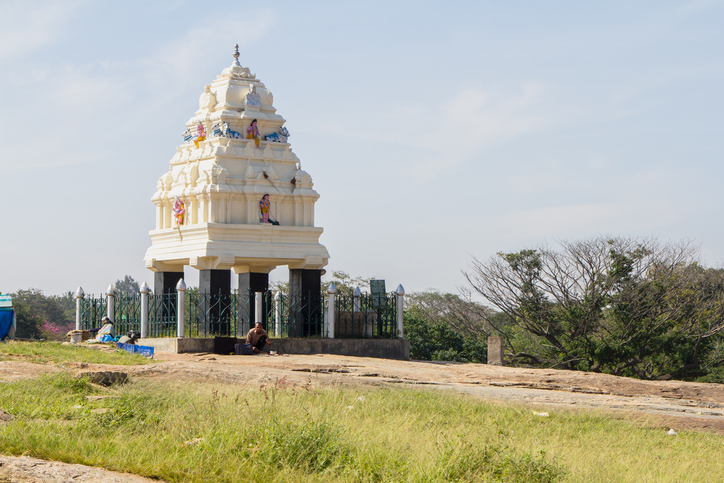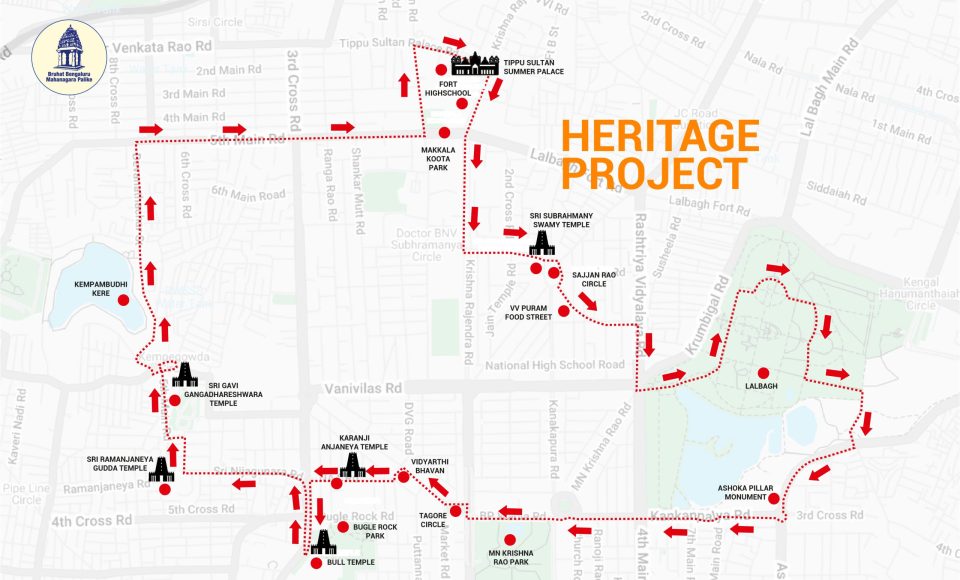
Brand Bengaluru: Govt lines up 15 hotspots for Kempe Gowda heritage corridor

Bengaluru, known by its famous monikers of ‘City of a thousand lakes’, ‘Garden city’, ‘Pensioner’s paradise’, ‘IT City’, and ‘Silicon City’, is set to assume a new name if the government’s plans to turn it into a heritage destination falls into place.
The Karnataka government plans to develop a corridor in the Old Bengaluru area by connecting 15 famous heritage hotspots on a 12-km stretch. Named after Kempe Gowda I, the 16thcentury chieftain who founded Bengaluru, the Nadaprabhu Kempe Gowda Corridor is among the four corridors (planned at the four cardinal points of the city) envisaged by the government as part of its flagship programme ‘Brand Bengaluru’.
Also read: Govt wants your suggestions for Bengaluru’s development. Just log in at this portal and do so
“Nadaprabhu Kempe Gowda Corridor, which will be located in south Bengaluru, will include two towers built by Kempe Gowda – Lalbagh and Kempambudhi towers,” Bruhat Bengaluru Mahanagara Palike (BBMP) special commissioner (finance) and nodal officer of ‘Vibrant Bengaluru’ theme Jayaram Raipura told The Federal.
Raipura said while the cost estimate of the project is yet to be made, it may cost around ₹500 crore. “A detailed plan report (DPR) is being prepared,” he said.
Vokkaliga connect
When the BJP was in power in the state, it was enthusiastic about building narratives based on communities to improve its Vokkaliga vote base in the region. The government also built a 108-foot-high statue of Kempe Gowda near the Bengaluru International Airport. ‘Sacred mud’ (mruthika) from Vokkaliga lands in the Old Mysuru region was brought to build the Kempe Gowda statue.

The Congress government has now taken the efforts to connect with Vokkaligas a notch higher by planning an entire tourism circuit dedicated to relics linked to the community. Deputy Chief Minister and Bengaluru Development Minister, DK Shivakumar, who is an aspiring Vokkaliga mass leader, has envisioned the Brand Bengaluru project to give the city a new look. The naming of the first of the four heritage corridors that will be built under the project, after Kempe Gowda, indicates the government’s attempts to appease the Vokkaliga community.
Special facilities along the corridor
“We plan to lay roads, footpaths and provide public facilities like street lights along the corridor. The corridor will be demarcated by painting a 1.5 mm polyethene road, without destroying the existing road and pavement,” Raipura said.
Also read: How Bengaluru-Chennai Expressway will reduce travel time, benefit 3 states
Open shelters, streetlights, furniture, signboards, and artwork will be installed at 24 locations, one every 500 m of the corridor. Location introduction information will be published. Special lighting arrangements will also be made at 24 special rest stops and main heritage sites of the corridor. A light and sound show will be arranged and an artificial intelligence mobile phone and app-based guide will be created within the corridor, he said.
Here’s a look at the 15 tourist hotspots that the Nadaprabhu Kempe Gowda Corridor will cover:
- Kempambudhi Lake and Park (Gavipuram)
Considered the deepest lake in Bengaluru, it was created after building a dam on Vrushabhavati river. It was built by Kempe Gowda in memory of his mother Kempammanni. The lake was the main source of water for the city in the initial years.
- Gavi Gangadhareshwara temple (Gavipuram)
The temple is said to have been built by Gautama Maharshi and Bharadwaja Muni in the Vedic period and renovated in the 16th century by Kempe Gowda. The temple is famous for its mysterious stone discs in the forecourt and architectural marvel of placement of a hole in the roof, allowing the sun to shine on the shrine during Makara Sankranti.
Also read: Tech capital Bengaluru becomes 1st Indian city to join global ‘culture’ forum
- Ramanjaneya Gudda temple (Hanumanthanagar)
A major temple dedicated to Lord Hanuman, it was built in the 1960s by former chief minister Kengal Hanumanthaiah. A giant statue of Lord Ram and Hanuman embraced in a tight hug is the highlight of this temple. The hill on which the temple is built is also home to a variety of flora and fauna while the temple often hosts cultural festivals on its large courtyard.
- Bull temple (Basavanagudi)
This is a landmark temple in South Bangalore with a history of 600 years. The temple, built in the Vijayanagara style, flaunts the second-largest monolith bull statue in India. The temple is the abode of Nandi, the bull of Lord Shiva. Legend has it that villagers around the temple grew groundnuts as a staple crop. But a bull used to come and eat all their yield. It was then that they struck a deal with Lord Nandi that they will offer an annual feast (Kadalekayi Parishe) during Karthika Maasa (January) every year if the bull doesn’t raid their crops. As promised, locals to this day offer groundnuts to the deity during the groundnut fair held on the last Monday or Tuesday of the Karthika Maasa every year.
- Bugle Rock Park (Basavanagudi)
The main attraction of the spot is a peninsular gneiss rock formation with an assessed age of around 3,000 million years, perched at an abrupt rise above the ground. The rock has attracted the scientific community to the spot for a long time. Kempe Gowda II built one of the four watchtowers for Bengaluru atop the rock. These towers were used to give warning bugles calls to people during attacks on the city by the enemy. The site is among the 26 Geological Monuments of India listed by the Geological Survey of India.
- Karanji Anjaneya Temple (Basavanagudi)
The temple flaunts one of the tallest Hanuman statues (18-ft high) on a monolith rock. The Hanuman statue has choodamani in its palms, depicting the mythological story of the monkey god bringing it to Lord Rama in the epic Ramayana. The temple is said to be over 500 years old. The Carnatic concerts held on the temple premises during the Ramnavami festival are a must to attend.
Also read: Top 30 high street locations in India: Bengaluru’s MG Road ranks first
- Vidyarthi Bhavan (Gandhi Bazar)
There is so much to talk about this landmark hotel of Gandhi Bazar, established in 1943 to cater to the then-students of National School and Acharya Patashala. Time has stopped still at this place and the lip-smacking masala dosai laced with ghee has not changed in the past 80 years. From chief ministers to foreign ambassadors, from Jnanpith awardees to freedom fighters, from business tycoons to scientists, and from movie stars to chief justices, everyone has been to this legendary eatery. The restaurant is closed on Fridays.
- Tagore Circle (Gandhi Bazar)
The iconic landmark located right at the entry point on KR Road stands witness to the struggle for Independence. This junction was the centre for meeting of freedom fighters and has a stage which has hosted many protest speeches.
- MN Krishna Rao Park (Jayanagar)
Spread across 25 acres, the square-shaped park is named after MN Krishna Rao, the acting Dewan of the princely state of Mysore in 1941. The two-storeyed Krishna Rao pavilion is situated at the centre of the park. The park was the first of its kind to be opened for women and children. Men were not allowed inside until the late 1960s. The structure was designed by Berlin-born Otto H Koenigsberger, chief architect and planner of Mysore state, whose repertoire also includes iconic structures like Bal Bhavan and buildings in the Indian Institute of Science.
Also read: Bengaluru to have Design District inspired by Dubai’s d3
- Ashoka Pillar (Jayanagar)
Considered a landmark spot in Bengaluru, it was erected by the civic authority CITB (City Improvement Trust Board) to mark the southern end of the city. It was inaugurated on August 20, 1948 by the last Governor General of India, C Rajagopalachari. The construction was completed within seven days at the cost of ₹3,000. At the time of its inauguration, it was hailed as the tallest pillar in Asia.
- Lalbagh Botanical Garden (Lalbagh)
The park encompasses the history of Bangalore within its 240-acred walled compound. It has stood the test of time and served as the lung space of the city for hundreds of years. The green patch of land around the southern tower built by Kempe Gowda II became a park when Hyder Ali wanted to replicate a Mughal Garden in 1760. His son Tipu Sultan got plants from all over the world for the park.
Also read: Rediscovering Lalbagh at Bengaluru’s spectacular flower show
The British took charge of the park in 1799, and groomed it into a horticultural haven. Lalbagh also has Peninsular Gneiss, a rock formation that is about three billion years old and is one of the oldest in the world. There are also two hero stones, or veeragallus, which are stone carvings that depict the stories of warriors who died in battle. These stones date back to the 10th and 13th centuries. The park hosts two flower shows every year, coinciding with Republic Day and Independence Day. It also has a large collection of rare plants and birds.
- VV Puram Food Street (VV Puram)
From piping hot bajjis to ‘Congress buns’, the city’s ‘thindi beedi’ holds a special place in the hearts of Bengalureans. VV Puram Food Street is a paradise for food lovers in Bengaluru. It has over 20 stalls serving vegetarian street food, sweets and cuisines from different regions of India and Asia. The place is a must-visit for anyone who wants to experience the diversity and deliciousness of Bengaluru’s food culture.
- Sajjan Rao Circle
Sajjan Rao Circle is a locality in Bangalore, Karnataka, known for its food street, temple and choultry. The food street is a lane with over 20 stalls offering vegetarian street food, sweets and cuisines from different regions of India and Asia. Eight roads congregate here and it is one of the biggest roundabouts in the world.
- Fort High School Circle (Chamarajpet)
Fort High School is a historic and prestigious school. It was built in 1907 by the Mysore Wodeyars as the first school in Karnataka. It was an Anglo-vernacular school that taught multiple languages and produced many eminent personalities in various fields. Kengal Hanumanthaiah, Kuvempu, Masti Venkatesha Iyengar, Dr. Rajkumar, Gundu Rao are some of its luminous alumni.
- Makkala Koota (Chamarajpet)
Makkala Koota is a unique and historic institution in Bangalore that provides a space for children to play, learn and enjoy. It was founded in 1938 by R Kalyanamma, a writer, social worker and the first woman vice-president of the then Bangalore municipality. She was inspired by the vision of Mahatma Gandhi and Rabindranath Tagore to create a place where children could have access to recreation, education and culture irrespective of their class and caste. It has been visited by many eminent personalities such as Jawaharlal Nehru, Rajendra Prasad, Sarvepalli Radhakrishnan, Jayaprakash Narayan, Rukmini Devi Arundale and others.


